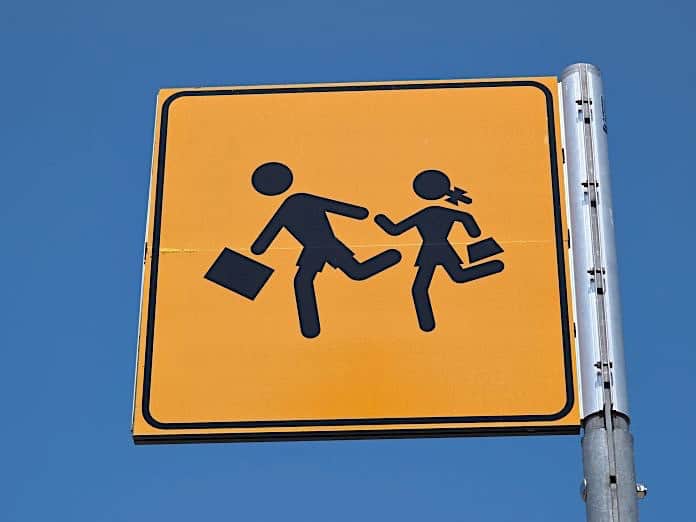One of the questions we ask applicants seeking our esteemed Relief (substitute) Driver position is this: “You are filling in for a regular route driver in the afternoon. At your first stop you notice the students, who cross the street in front of your bus, do not wait for you to signal that it is safe. What should you do?”
The applicants who receive top marks are the ones who say they will address the situation right then and there, by instructing the students to wait at the side of the road. In fact, very skilled Relief Drivers will proactively talk to the students well before they arrive at the first stop. Why? Because they know this is a perennial problem with both drivers and students.
So, given that this is an ongoing problem that needs to be addressed regularly, here are three things you can do to assure your students safely board and disembark from your bus, cross the street and clear the danger zone.
Coach — It all starts the first day in training. Instilling the seriousness of student stops is your top priority since loading and unloading represent the vast majority of student bus-related fatalities.
At Academy District 20 (Colorado Springs, Colo.), not only do we show a video demonstrating Danger Zones, but we physically walk our trainees around buses so they can experience first-hand all the blind spots in and around a school bus. By day two, each new trainee is expected to be able to verbally demonstrate unloading students and safely crossing the roadway. Likewise, trainees must show proficiency in managing and monitoring the danger zone (e.g., mirror checks) before moving on.
If your trainee is struggling with performing safe stops, here are a few things you can do to help them along.
- Switch places and have the trainee be the trainer and you drive. Purposely make mistakes so that your trainee can discover them and correct you.
- Also, sit behind the trainee as they drive and purposely distract them (obviously in a safe location). Reach forward to the console. Shut the lights off. Hit an Override button. Turn off the Master switch. Distracting them requires them to focus more acutely on the task at hand. It also helps then quickly recover from blunders which just may save them when they test for their CDL.
Check — Annually check your drivers’ skills by doing a supervisor level ride along check-ride. Don’t sugarcoat mistakes. If a driver is not performing and meeting your district standards, address the issue, take corrective action and document the outcomes. Be sure to accurately assess a driver’s ability to manage and monitor the danger zone. Be completely honest about their mirror checks before they move the bus. Insist, and make no concessions, that the parking brake is always first on and last off.
Also, we watch onboard video of each driver twice a year. We use this opportunity to evaluate the driver’s skills when they are relaxed and think they are not being watched.
The big picture is this: You are creating a department-wide culture of safety. Drivers will start policing other drivers, because they know they are being observed on a regular basis.
Correct — Ignorance is bliss right? Not! Here is a universal rule about pupil transportation: Once you discover a problem, you are now obligated to address it and fix it. Ignoring the problem just creates more risk and liabilities.
Having a robust training department is your best defense. Once you discover an area of concern, do not permit a driver to operate a school transportation vehicle until they can demonstrate proficiency. You must have the mentality that you will drive that vehicle before you will permit an unsafe driver to operate a school bus. You can send a strong message to all your drivers by putting unsafe drivers on Administrative Leave without pay until they successfully complete refresher training.
Don’t be afraid to pull a driver off a route if you find any unsatisfactory behavior. That is better than letting them drive and cause a disaster that makes the cover of STN! Again, directly address any unsatisfactory behavior, including writing a “Letter of Concern” to your HR department, assigning refresher training—or, if need be, moving toward termination.
Given shortages in commercial drivers, you may experience the temptation to look the other way when observing unsafe driving. Don’t do it! All of us are in this industry because we have a heart for ensuring each and every student arrives at school safely and on-time, so they have the opportunity to do their very best. Likewise, as a leader in transportation, your heart must extend to ensuring each and every driver has your full support and access to unlimited coaching, so they have the opportunity to do their very best.
 Robert Leach is a Transportation Supervisor at Academy District 20 in Colorado Springs, Colorado. He is responsible for recruiting, training, and relief/substitute drivers. In 2017, he was named “Colorado’s Best Trainer” by the Colorado State Pupil Transportation Association. Robert writes and teaches frequently on organization development, strategic planning and business ethics. He can be reached at robert.leach@asd20.org.
Robert Leach is a Transportation Supervisor at Academy District 20 in Colorado Springs, Colorado. He is responsible for recruiting, training, and relief/substitute drivers. In 2017, he was named “Colorado’s Best Trainer” by the Colorado State Pupil Transportation Association. Robert writes and teaches frequently on organization development, strategic planning and business ethics. He can be reached at robert.leach@asd20.org.
















